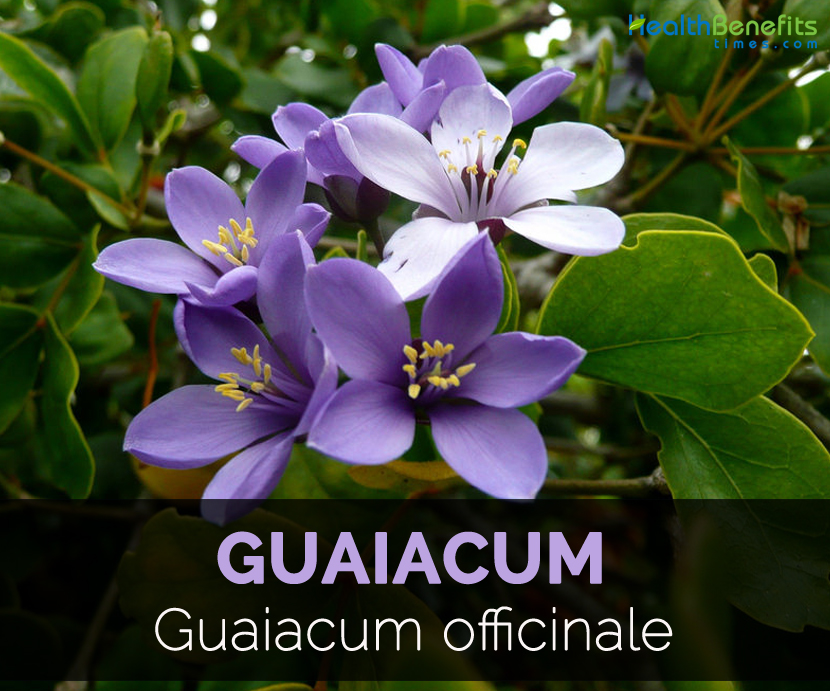| Guaiacum Quick Facts | |
|---|---|
| Name: | Guaiacum |
| Scientific Name: | Guaiacum officinale |
| Origin | Native to Caribbean and Northern coast of South America. |
| Colors | Bright yellow to orange |
| Shapes | Bilocular, cordate capsule |
| Flesh colors | Red |
Guaiacum is used as a diuretic, laxative and to induce sweat in fevers. It is used by medical practitioners as a treatment for syphilis with sarsaparilla and sassafras tree. The resin from the tree is composed of polytriterpenoids guaiaguttin, guaiaconic, resin acids, guacic acids, guaianetic and saponins. The resin possess anti-inflammatory activities which is useful for arthritis, rheumatism and gout. The resin when obtained from the tree is red to brown in color which turns into blue to green hue as exposed to oxygen which could be useful for staining and is also applied to provide relief from toothache.
History
Native to West Indies and North coast of South America, its range was expanded from Florida Keys to Venezuela, Panama and Honduras. In 16th century, the Spanish explorers were known to this tree in Bahamas and derived its name from indigenous languages. It is used for construction, precision instruments and formation of small intricate parts of grandfather clocks due to its longevity.
Plant
The word Guaiacum was derived from Caribbian. Guaiacum is a slow growing, broad leaf and small tree which grows with trunk diameter of 60 cm and upto 12 m in height. The compound leaves are 2 cm wide and 2.5-3 cm long. Flowers are bluish purple, showy and 2.5 cm across with five petals that gives way to bright yellow to orange fruit. Fruit has red flesh with black seeds in it. The flower blooms from March to October.
Flower and Fruit
Flowers are pale blue of star shaped with 6-10 blooms and 2 cm long pedicles. It has 5 petals, 5 sepals and 10 stamens with bilocular ovary. Flowers appear in great profusion and remain for a long time covering the tree. When the older flowers fade from deep blue to paler becoming white then a striking variegation of color is produced. Flowers appear at the end of branches. Each flower has small and finely hairy calyx. There are 10 stamens with golden yellow anthers. Fruit is a bilocular and cordate capsule which is compressed on a side and contains long and hard seed.
Leaves, root and stem
The plant grows up to the height of 13 m with greenish to brown twisted trunk, knotty branches and deeply furrowed bark. It has crooked stem which is intensely hard. It has greenish brown heartwood that has aromatic taste. Leaves are coriaceous, short petioled and di to tri pinnate. Each leaf has 2-3 pair of smooth and stalkless leaflets which are arranged on slender mid-rib. It has obtuse, ovate or oblong and entire margined leaflets of 6-13 cm long.
Traditional uses
- Guaiacum is useful for skin disorders, respiratory complaints and syphilis.
- Use resin or wood internally for dryness of mouth, thirst and excite warmth in stomach.
- It stimulates heat of the body and promotes circulation.
- Use it to treat cutaneous diseases, chronic rheumatism, syphilitic diseases and scrofula.
- It is an aid for rheumatism, dysmenorrhea and uterine affections.
- Resin is used to treat toothache.
- Use it externally to provide relief from rheumatism.
- Its oral use is useful for blood pressure, tonsillitis, gout and arteriosclerosis.
- As a mouthwash, it is used to eliminate bacteria.
- It promotes discharge of mucous and evacuation of bowels.
- It stimulates circulation and purification of blood.
- The tea made from flowers is used to cure bronchitis, asthma, colds, coughs, flu and excess buildup of mucus as well as congestion.
- Massage to the painful joints and muscles with an extract obtained from wood chips by placing it in alcohol.
- Apply the mixture externally made by boiling some wood chips to lower swelling, pain and redness related to arthritis.
- Mix the powder with water and gargle to assist tonsillitis.
- The wood is helpful for gastric ulcers and gastritis.
- Intake a tea made with wood of Guaiacum to lower blood pressure.
- Guaiacum also assists in elimination of uric acid.
- Apply a paste of inner bark for treating muscular pains and sprains.
- Use the decoction of wood as a mouth wash to improve oral health and cure oral ulcers.
- Combine the mashed leaves of Guaiacum with coconut oil to aid blisters, skin sores, abscesses and boils.
Precautions
- People who are allergic, hypersensitive and have acute inflammatory conditions should avoid it.
- It is better to be avoided by lactation and pregnant women.
- Excessive use can result in gastroenteritis, diarrhea and intestinal colic.
- To remain on safe side, consult the health practitioner for use.
- It might cause allergic reactions such as tightness in throat or chest, breathing problems, skin hives, swollen skin, rash and chest pain.
How to Eat
Resin obtained from tree is used to flavor chewing gum and cakes.
References:
https://www.itis.gov/servlet/SingleRpt/SingleRpt?search_topic=TSN&search_value=897104#null
http://davesgarden.com/guides/pf/go/55943/
http://www.pfaf.org/user/Plant.aspx?LatinName=Guaiacum+officinale
http://www.botanical.com/botanical/mgmh/g/guaiac42.html
http://www.flowersofindia.net/catalog/slides/Tree%20of%20Life.html
http://ecocrop.fao.org/ecocrop/srv/en/cropView?id=6558
http://www.worldagroforestry.org/treedb/AFTPDFS/Guaiacum_officinale.PDF
http://www.chinese-herbs.org/guaiacum/
http://herbs-treatandtaste.blogspot.com/2011/12/guaiacum-officinale-producer-of-lignum.html
http://greatplainsregional.adam.com/content.aspx?productId=48&pid=48&gid=10093
http://www.askdrmao.com/natural-health-dictionary/guaiacum-resin/
https://paulhaider.wordpress.com/2015/08/20/the-tree-of-life-great-for-hiv-and-arthritis/
Comments
comments
